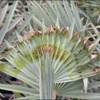Abstract
Chronic boron deficiency is believed to be caused by soil drying and high soil pH, while temporary deficiency is caused by heavy leaching. It results in a wide array of symptoms, not only among species of palms, but also within a single species. This revised 5-page fact sheet contains many illustrations to aid in diagnosis and management recommendations. Written by Timothy K. Broschat and published by the UF Department of Environmental Horticulture, June 2011.
References
Broschat, T.K. 1984. Nutrient deficiency symptoms in five species of palms grown as foliage plants. Principes 28:6-14.
Broschat, T.K. Boron deficiency symptoms of palms. Palms 51:115-126.
Broschat, T.K. Boron deficiency, phenoxy herbicides, stem bending, and branching in palms-is there a connection? Palms 51:161-163.
Broschat, T.K. 2008. Release rates of soluble and controlled release boron fertilizers. HortTechnology 18:471-474. https://doi.org/10.21273/HORTTECH.18.3.471
Brunin, C. and P. Coomans. 1973. La carence en bore sur jeunes cocotiers en Côte DIvoire. Oléagineux 28:229-234.
Bull, R.A. 1961. Studies on the deficiency symptoms of the oil palm. 3. Micronutrient deficiency symptoms in oil palm seedlings grown in sand culture. J. West African Inst. Oil Palm Res. 3:265-272.
Manciot, E., M. Ollagnier, and R. Ochs. 1979-80. Mineral nutrition of the coconut around the world. Oléagineux 34:511-515; 576-580; 35:23-27.
Marlatt, R. B. 1978. Boron deficiency and toxicity symptoms in Ficus elastica and Chrysalidocarpus lutescens. HortScience 13:442-443.
Ollagnier, M. and G. Valverde. 1968. Contribution à letude de la carence en bore du palmier à huile. Oléagineux 23:359-366.

